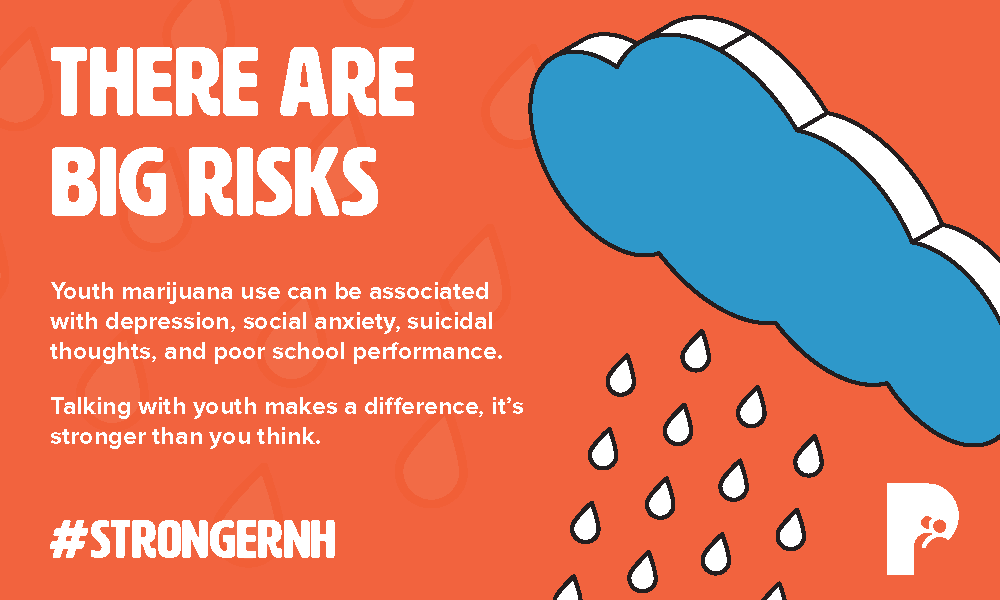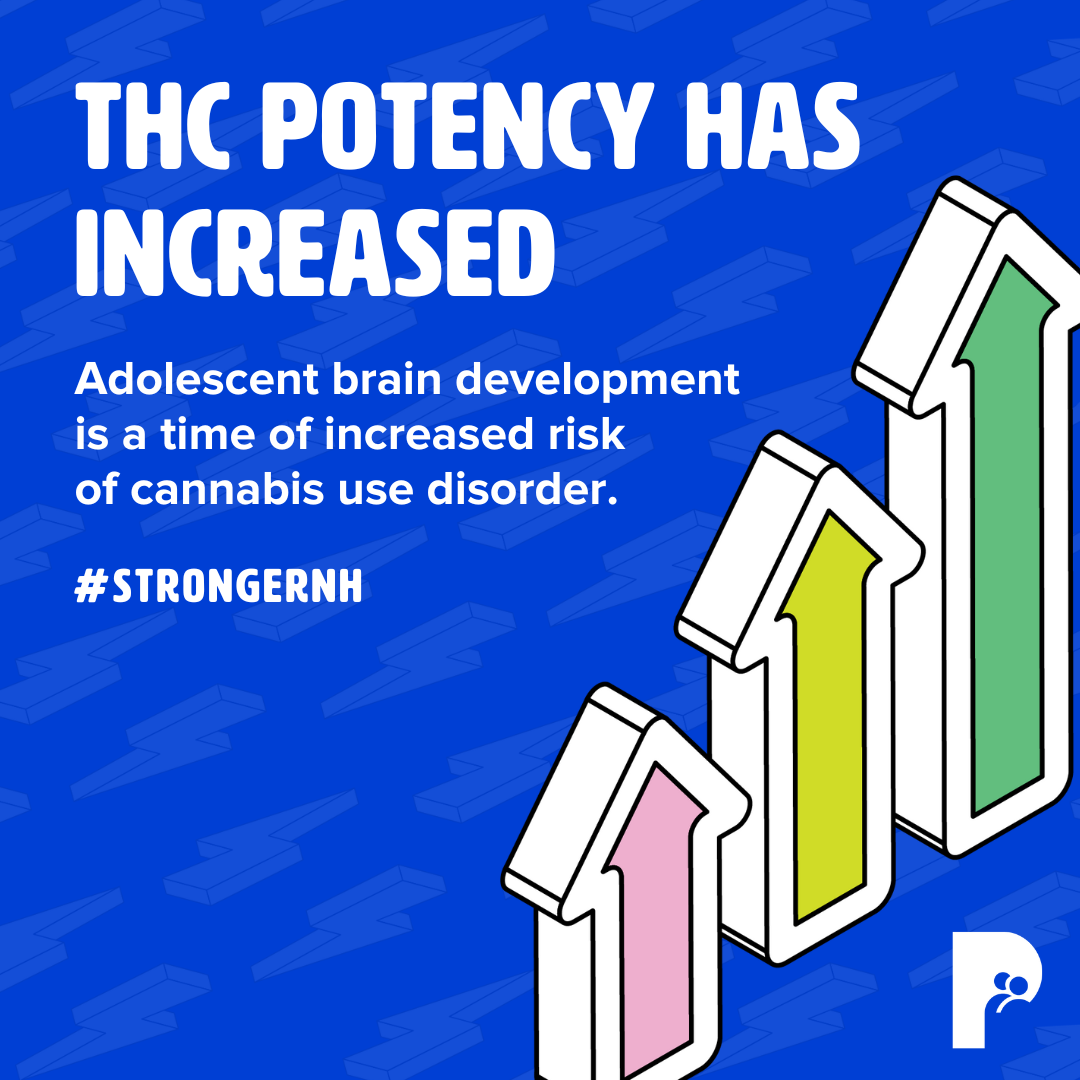Stronger Than You Think
As a parent or caregiver, you are the number one influence on whether a child you care for chooses to use cannabis, tobacco, alcohol, or other drugs. You are their guide and role model.
What you say to the youth in your life is stronger than you think.
The Stronger Than You Think campaign supports open conversations between parents, caregivers, and adults who have strong relationships with youth, and the young people in their lives. The campaign highlights the importance of having conversations about:
- Expectations around using substances
- Setting age-appropriate boundaries
- Planning safe activities and accountability
- Educating about the risks and consequences of using any substance


Additionally, modeling responsible use sets a good example. Young people will learn how to manage stress from adults and, if substances are a part of your life, how you use them.
Share the Stronger Than You Think campaign to help educate others and support the New Hampshire prevention community’s response to the harmful effects of substance use on youth. Click the buttons below!
Even if cannabis/marijuana is right for you, it’s not for them. As an adult you may choose to use cannabis/marijuana for a number of reasons, including a decision you have made with your healthcare provider. But it is important to understand and educate young people about the risks associated with their use of the product.
Our brains don’t fully develop until late adolescence, around age 25, and any cannabis use before that can have long term effects. Increasing evidence finds that cannabis use among young people may be associated with cognitive deficits, such as impaired learning, and physical changes in the brain, affecting attention and memory. Developing brains are still building pathways and connections. Substance use during this process can alter how the paths and connections are made.


Risks of Youth Cannabis Use
Youth cannabis use can be also associated with depression, social anxiety, suicidal thoughts, and poor school performance.
Risks of High THC Cannabis Use
Tetrahydrocannabinol (THC) is the psychoactive ingredient in cannabis that gives the high. THC potency has increased in cannabis from less than 4% in the 1980s to up to 30% in the current market, with concentrates containing 40% to 90% potency.


Increased Risk
High concentrations of THC increase risk of:
- Drug poisoning (overdose)
- Psychosis
- Suicidality
- Addiction (also known as cannabis use disorder or substance use disorder)
Fentanyl-laced drugs are widespread, and the first dose can be deadly. Fentanyl is estimated to be 50 times more powerful than heroin and 100 times more powerful than morphine. Just two milligrams of fentanyl, the size of two grains of salt, is enough to end a young person’s life. In 2022, about 85% of drug overdose deaths in New Hampshire involved fentanyl.
Opioids are a group of drugs that include synthetic opioids like fentanyl, illegal drugs like heroin, and legal prescription pain relievers such as oxycodone (OxyContin®), hydrocodone (Vicodin®), codeine, and morphine.

It is not just opioids that may be fake or altered. Any pill or powder from a source other than a healthcare provider or pharmacy should be assumed to contain fentanyl. This includes when youth may think they are getting a “study drug” like adderall, from a friend.
Talk with the young people in your life about the real probabilities that the drugs they may think they are being offered, could actually contain deadly substances. Encourage the youth in your life to carry naloxone and become trained on how to use it. Since overdose can happen to anyone, even someone using opioids for the first time, it’s important for you to carry naloxone, have it at home, and learn how to use it as well. In NH, this life-saving medication is available at any of the nine Doorways, through a prescription from your healthcare provider, and without a prescription at many pharmacies throughout the state.

Risks of Youth Opioid Use
Risks include, but are not limited to:
- Allergic reactions
- Coma
- Breathing problems
- Permanent brain damage
- Death
Risks of New Substances Entering the Illegal/Counterfeit Drug Supply
- Xylazine is not an opioid, but it is a depressant that slows down a person’s breathing and brain function.
- Similar to fentanyl, you cannot see, taste, or smell xylazine.
- Fentanyl test strips can be used to detect the presence of fentanyl, strips for people to test a drug for xylazine are currently awaiting release to the market.

At the most basic level, we know that drinking during adolescence (under 20 years of age) puts youth at risk for developing an alcohol use disorder (previously called alcohol addiction). Developing brains are still building pathways and connections (even up to age 25). The introduction of substances, like alcohol, during this building process can alter how the pathways and connections are made.

The concept of “learning to drink” is not real. Using alcohol is not actually something you should practice, like driving.
Nationally almost 18% of young people 12-17 say they have had alcohol in the past year. And in New Hampshire, about 21% of high school students reported they had at least one drink of alcohol, on at least one day during the past 30 days.
Research shows that “parenting styles” or impactful youth-adult relationships can affect whether or not teens choose to drink. Children whose parents or caretakers set clear boundaries and keep close track of their teen while showing care and love are less likely to drink alcohol underage.
- Keep communication open, honest and respectful.
- Know where the young person is going, who will be there and if alcohol will be present.
- Make a plan so that the young person can let you know that they are uncomfortable and secretly ask to be picked up.
- Model responsible alcohol use.

Risks of Youth Alcohol Use
Using alcohol during youth and young adulthood can impact the developing brain and young people can be more likely to develop an alcohol use disorder (alcohol addiction) and increases the chance for risky behaviors.
Binge Drinking Risks for Youth
- Each year, 5,000 people under the age of 21 die from alcohol-related car crashes, homicides, suicides, alcohol poisoning, and other injuries, such as falls, burns, and drowning.
- Binge drinking is responsible for more than 25,000 years of potential life lost among people under 21 each year.
- There is also a strong connection between teen alcohol use and depression, poor school performance, fighting, stealing, and unintended sex.

Stimulants increase attention, alertness, and energy. Stimulants are often prescribed to treat attention deficit hyperactivity disorder (ADHD), a therapy that has increased in the last two decades. The fact that the prescription has become more common may decrease the perception of risk of using the substances in ways other than as prescribed. A young person may misuse prescription stimulants, or take illegal/copycat stimulants or illegal methamphetamine, thinking the substances will help them perform better at school by staying focused, alert, and awake.
When taken any way other than as prescribed—including taking someone else’s prescription and taking the stimulant to get high—prescription stimulants can be dangerous and addictive. However, prescription stimulants are one of the most commonly shared and misused prescription drugs among teens. Medication-sharing among teens is a big reason that youth who aren’t on stimulant therapy have access to prescription stimulants. Fake pills made to look like prescription medications have been found to contain methamphetamine or other chemicals. Because of the way it is made, each batch is different in potency or contents and can be laced with other harmful substances, including fentanyl.

A recent study found that schools with the highest rates of teens using prescribed ADHD medications were about 36% more likely to have students misusing prescription stimulants during the past year. A 2020 survey conducted by the Centers for Disease Control and Prevention (CDC) found that just under 25% of young adults aged 18 to 24 initiated or increased substance use as a means of coping with pandemic related stress and emotions.
The protective factors that can lessen or weaken the likelihood that a young person will use substances exist at each level of the socio-ecological model: individual, family, and relationship, community and peers, and society and culture. Children whose parents or caretakers set clear boundaries and keep close track of their teen while showing care and love are less likely to misuse or take stimulants.
- Start talking to your teen about managing their medications.
- Educate the young people you care for about the consequences of prescription stimulant misuse and dispel the myths they may have heard about them enhancing their performance at their studies.
- Role play so kids know how to respond if asked to share their prescription stimulants.
- Always store controlled substances in a lockbox and monitor pill counts.
- Make sure schools have safe storage and dispensing policies, and ask if they are aware of misuse within the student body.

Risks of Youth Stimulant Use
When taken at greater than therapeutic doses, prescription stimulants may have serious health consequences, which can include:
- A dangerous increase in body temperature
- Seizures
- Adverse cardiac events
Over 97% of youth who misuse prescription stimulants by age 18 have also used at least one other substance in the past year (usually alcohol or marijuana). Long-term use can lead to stimulant use disorder or other substance use disorders.

Feel strongly or want more information?
Please find more resources located throughout our site on the pages listed below.
Prevention Campaigns & Toolkits
Click on each individual image to view and/or download. Please note that each palm card is double-sided. Want to order free hard copies? Visit our order form here!
Stronger Than You Think Campaign Social Media Toolkit
This social media toolkit includes sample messages and images from the Stronger Than You Think campaign to encourage prevention partners to help educate and support our community response to the harmful effects of substance use on youth. Messages can be modified to suit your needs. (Right-click+Save As on each individual image to download.)
Important Note on the Use of the Term Cannabis
Important Note: The Partnership uses the term cannabis to refer to the plant and all types of derived products such as—vape cartridges, edibles, smokable “weed” or “pot”, oils and tinctures. We are not using the term marijuana on most of our resources because this term has a complicated past that was slanderous towards certain people. It is, however, important that the language we use in some instances is accessible to the audience that we are trying to reach and we understand that marijuana is a commonly utilized term for products that contain the form of THC (Delta 9) that provides a euphoric affect or intoxication.






























